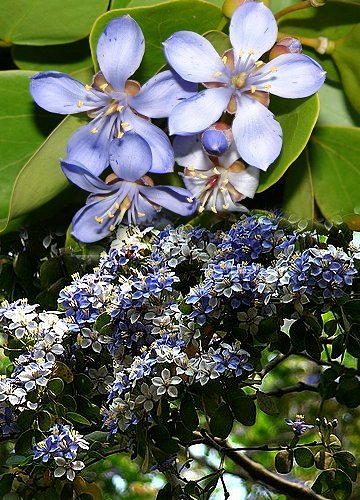
|
|
Guaiac Tree (Guaiacum officinale).
Flowers.
|
Guaiac Tree - Guaiacum officinale
- Lignum-vitae
Guaiacum, sometimes spelled Guajacum, is a genus of flowering plants in the caltrop family Zygophyllaceae. It contains five species of slow-growing shrubs and trees, reaching a height of approximately 20 m (66 ft) but are usually less than half of that. All are native to subtropical and tropical regions of the Americas and are commonly known as lignum-vitae, guayacan (Spanish), or gaiac (French). The genus name originated in Maipurean, the language spoken by the native Tainos of the Bahamas; it was adopted by English in 1533, the first word in that language of American origin.
Members of the genus have a variety of uses, including as lumber, for medicinal purposes, and as ornamentals.
Guaiacum officinale is the national flower of Jamaica, while Guaiacum sanctum is the national tree of The Bahamas.
Guaiacum officinale, commonly known as Roughbark Lignum-vitae, is
native to the Caribbean and the northern coast of South America. Guaiacum officinaleis
is a very slow growing ornamental
evergreen tree grows to a height of 9-12 m. Stem is generally crooked wood intensely hard, the branches knotty and bark deeply furrowed. The dense crown of close-growing foliage gives the tree a rounded, compact, net appearance. Each leaf is composed of 2 or 3 pairs of smooth, stalkless leaflets arranged on a slender mid-rib. The leaflets are 6-13 cm in length. There is much irregularity both in their size and shape: some are broadest above the middle (obovate), some almost blunt (obtuse). Beautiful blue flowers grow in great profusion and almost cover the tree and remain for a long time. As the older blooms fade from deep blue to paler shades, some becoming almost white, a striking variegation of colour is produced. The flowers grow in clusters at the ends of the branches. Each flower has 5 petals cupped in a small, finely hairy calyx, supported on a slender stalk. There are 10 stamens bearing golden yellow anthers. The fruit appears as small, round, compressed, yellow capsules, containing 5 cells; occasionally there are fewer. Each cell encloses a single seed.
The wood is extraordinarily heavy, solid and dense,
fibres cross-grained. It will easily sink in water. The old heart wood is dark green, the sap wood
little in quantity and of a much lighter yellowish colour; the wood is largely
used by turners, where weight is not an obstacle; it is very hard and durable,
suitable for making black sheaves, pestles, pulleys, rulers, skittle boards, etc.;
it has a slight acrid taste and is odourless, unless heated, when it emits an
agreeable scent. The bark yields 1 per cent volatile oil of delicious fragrance.
The genus Guaiacum is famous as the supplier of Lignum vitae, which is the heartwood of several species in the genus. It is the hardest wood that is measured using the Janka hardness test.
G. officinale is one of two species yielding the true lignum vitae, the other being Guaiacum sanctum.
Guaiacum wood has been an article of trade since 1508, when it was introduced, via Spain, to the medical profession of Europe as a specific for many of the most serious diseases of mankind
like syphilis. The name lignum-vitae (wood of life) originated from the supposition that the material was possessed of extraordinary remedial powers. So great was the demand that for a time the wood was sold for as much as 7 gold crowns a pound. Numerous learned treatises were published and served to establish the reputation of the wood so firmly that it was nearly 200 years before it was seriously questioned.
Later on the natural resin Guaiac obtained from the wood was introduced and now is greatly preferred, for medicinal use, to the wood. The wood is sometimes sold by chemists in the form of fine shavings, and as such called Lignum Vitae, which are turned green by exposure to the air, and bluish green by the action of nitric fumes. This test proves its genuiness. Guaiac cards are impregnated with the resin and are used in determining whether stool contains blood.
Both wood and resin are now medicinally obsolete except in certain proprietary decoctions.
Roughbark Lignum-vitae was listed as an endangered species by the IUCN in 1998. It has been overexploited for its valuable wood and medicinal products. International trade of this species is restricted because of its placement in CITES Appendix
II.
Source:
http://en.wikipedia.org/wiki/Guaiacum
http://en.wikipedia.org/wiki/Guaiacum_officinale
http://www.worldagroforestry.org/sea/Products/
AFDbases/af/asp/SpeciesInfo.asp?SpID=941
http://botanical.com/botanical/mgmh/g/guaiac42.html
